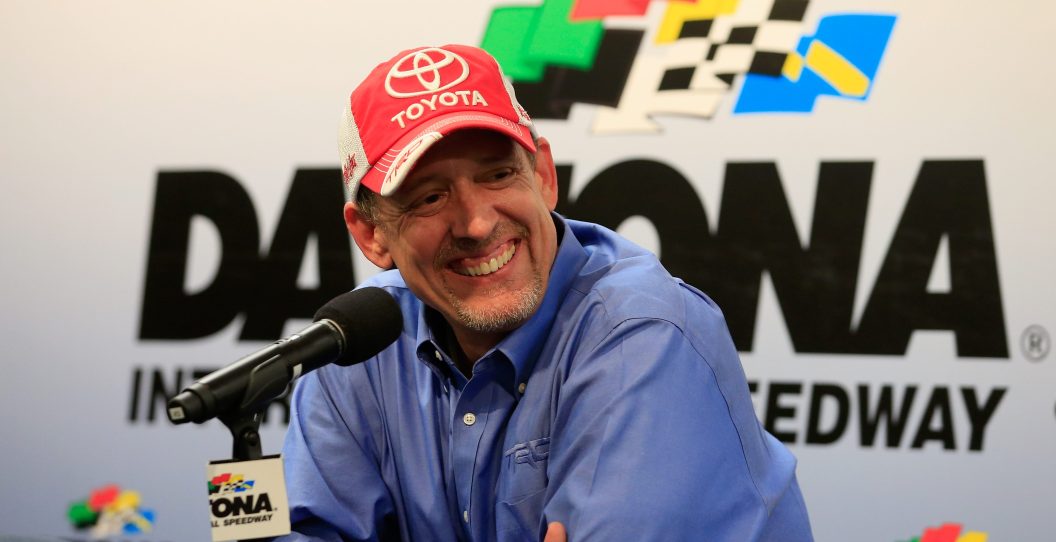Toyota Racing President, David Wilson, is saying that Toyota is open to raising the horsepower of NASCAR's Next Gen car to improve the car's racing ability on short tracks — ovals that are less than 1 mile long — and road courses.
Videos by FanBuzz
It has been no secret that NASCAR Cup Series races at the short tracks in particular has been lackluster at best since the Series adopted the Next Gen car before the 2022 season. Now going into the third year with the car, NASCAR continues to work on its problem at the short tracks.
With the Next Gen car, the racing at intermediate tracks — ovals that are between 1 and 2 miles long — has excelled and brought the best racing the sport has to offer. The racing at these tracks before the Next Gen car brought less action and excitement than short tracks and road courses, and attendance at the intermediate tracks suffered. As a result, NASCAR slowly diminished the number of races held at immediate tracks. In 2013, not counting super speedways (Daytona and Talladega), there were 18 races on intermediate ovals. In 2023, that number was 14.
With almost half the schedule consisting of short tracks and road courses, things certainly need to improve with the cars and how they race or NASCAR may face similar attendance woes at short tracks as it previously did at the intermediate tracks. For their part, drivers have pointed their fingers at a few issues that have hurt racing on short tracks, including the tires not wearing enough, shifting gears going into corners and a general lack of horsepower.
Lower tire wear slows tire performance fall-off as a green flag run goes. If the cars go the same speed throughout a run, it's harder to make passes on the track. There have been multiple occasions since 2022, when a car with tires that are at least 50 laps old has kept ahead of cars with much fresher tires.
Shifting at the short tracks has been a point of emphasis for the drivers when it comes to trying to pinpoint the main reason for the lackluster racing. Since the Next Gen car's introduction, drivers have learned that they can overdrive corner and compensate for it by downshifting, again making it more difficult for faster cars to pass.
With the Next Gen car's engines sitting at 670 horsepower, many drivers believe the cars too easy to drive, bringing the gap between the sport's best and its less talented drivers even closer and diminishing passing opportunities.
Each of these issues can be solved one way — pump up the ponies under the hood. NASCAR engine builders are now producing engines that are stronger than ever. They rarely fail and can be used for multiple races. Toyota Racing's Wilson says raising horsepower seems worth the risk if it improves the short track racing.
"We'd like to see better racing, and the path to that — we're open to about anything," Wilson tells The Athletic's Jeff Gluck. "If the consensus is we need to put the power back up, then we're on board."
Toyota's @DavidWilsonTRD: "We’d like to see better racing [at short tracks], and the path to that — we’re open to about anything. If the consensus is we need to put the power back up, then we’re on board." - @TheAthletic https://t.co/6KYa7KlnLy
— Adam Stern (@A_S12) January 25, 2024
Getting the engines back up to 750 hp — the level they ran on the short tracks before the Next Gen car — would not be an issue according to Roush Yates Engines CEO Doug Yates.
But it does not seem like NASCAR is in any hurry to add horsepower. Back in November, NASCAR President Steve Phelps said he doesn't agree that a lack of horsepower is the issue.
"I don't think the answer is more horsepower because more horsepower is expensive," Phelps said. "If you ask a driver what's going to solve it, they're always going to solve it, they're always going to say, 'Give me more horsepower.' It's a thing. I'm not a driver, but I've listened to enough drivers and that's their solution. So, the question is is that really what it is? I don't know. I think there are some things that we're looking at as well. Some shifting things."
NASCAR has made some adjustments to the cars for the short tracks and road courses for 2024. There will be a simplified diffuser which is shorter and narrower, which will allow for more maneuverability. The Series will also add an inch to the rear spoiler to add more downforce.
Time will tell if these changes help the racing at the short tracks, but it does not appear that increasing horsepower will be in the cards for 2024. Hearing that the manufacturers are willing to increase horsepower could open the possibility up in the future though.
If things don't get much better in 2024, then NASCAR may have to listen to the drivers and give them more horsepower they want to save short track racing.
More: Jeff Gordon Critiques NASCAR Next Gen Car
